The digital age has changed the way of communication and interaction between people and the way of processing information in the modern world. With smartphones, computers and tablets, people are now more connected than they have ever been. But this connectivity comes at a price: from the eye strain, the migraine from the constant light, the notifications, and the information overload. This side effect, called digital fatigue, impacts the cognitive performance, the emotional state, and the productivity of the individuals.
In this paper, I aim to explain the processes that lead to digital fatigue and the strategies that can be used to prevent or reduce the severity of the symptoms in order to have a more balanced relationship with technology and be more efficient and focused.
The Cognitive Overload of Constant Connectivity
The current environment is such that the human brain is not well positioned to receive and comprehend large amounts of information at one time. Digital platforms demand attention all the time, which makes people perform multiple tasks at the same time and switch between tasks frequently. Recent studies show that such a fragmented attention span is less efficient, stress-inducing, and memory-damaging.
Some of the main factors that lead to cognitive overload are:
- Information Overconsumption: Every day, the brain receives an unprecedented volume of information – emails, social network updates, news feeds, and so on. The constant flow of data makes it difficult to distinguish what is important and what is not, and leads to mental exhaustion.
- Notification Overload: The frequency of interruptions hinders concentration, and the person feels the need to respond to the signals, which are unnecessary.
- Multitasking Myth: The truth is that multitasking is a myth, and it only reduces the efficiency of the cognitive function and increases the errors that are likely to be made through task switching.
The Impact of Digital Fatigue on Mental Health
A negative impact of long term exposure to digital screens and high information consumption is a detriment to mental well-being. Digital fatigue has several psychological and emotional symptoms:

1) Increased Stress and Anxiety: The digital dependency comes from the need to always stay updated, and this leads to anxiety from the fear of missing information.
2) Reduced Attention Span: The use of digital media for prolonged periods condition the brain to demand instant gratification, making it difficult to concentrate on long form content or deep thinking.
3) Emotional Exhaustion: The high intensity of online interactions, the curated content, and the social comparison lead to feelings of inadequacy and burnout.
The Impact of Excessive Exposure to Digital Devices on Physical Health
Cognitive and emotional effects of digital fatigue are real, and it also has a negative impact on physical well-being. The most typical physical symptoms are:
- Eye Strain and Discomfort: It results in dry eyes, blurred vision, and headaches due to reduced blinking and your exposure to blue light.
- Sleep Disruptions: Blue light from screens reduces melatonin production, which makes it harder to fall asleep and affects sleep quality.
- Postural Issues: This paper also notes that poor posture when using digital devices leads to neck pain, back pain, and repetitive strain injuries.
Strategies to Combat Digital Fatigue
Fighting digital fatigue needs planned changes in the usage of technology. Some of them are:
- Screen Time Awareness: Tracking screen time is a way of managing excessive use of the digital device. Restricting the use of social media and other entertaining apps is very useful in improving focus.
- The 20-20-20 Rule: To avoid eye fatigue, take a 20-second break every 20 minutes and look at something at 20 feet away.
- Scheduled Breaks: Breaks from screens at regular intervals give the brain a chance to recover and prevent cognitive fatigue.
The Role of Mindful Technology Use
Mindful use of digital products means setting rules and using technology in a controlled manner. Some ways to do this include:
- Tech-Free Zones: Making certain parts of the house, for example the bedroom or the dining table, free from technology helps to avoid overexposure to digital content.
- Notification Management: It is very easy to get distracted by notifications, and they should be disabled for those things that are not really important and are just there to distract. This would enable one to focus better.
- Prioritization of Offline Activities: This ensures that people also engage in other activities like reading physical copies of books, exercising, and spending time in outdoor activities to reduce the frequency of digital consumption.
The Future of Digital Well-Being
As technology evolves, digital fatigue is only going to get worse. Therefore, employers, educators, and policymakers must acknowledge the necessity of systematic digital well-being measures – from screen time rules to flexible working and digital sabbaticals.
Artificial intelligence and other new technologies could also help to prevent digital fatigue by suggesting better digital habits for the individual, by limiting the amount of content entered and by encouraging more conscious screen use.
Digital fatigue is a modern epidemic, increasing as we move more into the digital world. It has been helpful to incorporate technology into our lives; however, overexposure to digital content and uncontrolled digital consumption results in cognitive overload, emotional exhaustion, and physical strain. By following some mindful technology habits, creating some digital boundaries, and putting time into the offline world, people can once again take charge of their mental and physical health. A balanced use of technology means that people are productive at work without neglecting their health, thus making digital interaction more sustainable in the long run.

